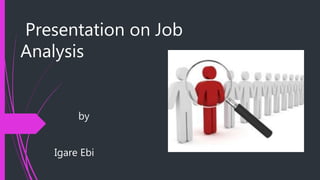
Job Analysis Presentation Outline
- 2. Presentation Outline To know what job analysis is Steps involved in Job Analysis Importance of Job Analysis Aspects of jobs to be analyzed Conclusion
- 3. What is Job Analysis This is a process to identify and determine in detail the particular job duties and requirements and the relative importance of these duties for a given job. Process where judgments are made about data collected. It involves job specification and job description
- 5. Steps to take in jobs analysis The information obtained in a job analysis aims to answer three main questions about the job which are ; What is to be done? Under what condition should it be done? What SKA and qualities are required to perform the analysis?
- 6. Steps to take in jobs Analysis There are five steps in job analysis process which are: Proper timing for conducting job analysis Collecting of information relating to job which includes; questionnaires, observation and interviews Preparing Job Description Forms Preparing Job Specification Preparing Report to be reviewed by the HR.
- 7. Importance of Job Analysis The purpose of Job Analysis is to establish and document the job relatedness' of employment procedures such as: Selection, compensation Training Performance appraisal
- 8. Compensation It can also be used in compensation to identify or determine Skills level Compensable actors Work environment Responsibilities Required level of education
- 9. Training Job analysis can be used for training and needs assessment to identify the following Training condition Assessment test used to identify effectiveness' Equipment's used in delivering the training
- 10. Performance appraisal Job analysis can be sued in performance review to identify and develop Goals and objectives Performance and evaluation Evaluation criteria's Duties of probationary/trying periods
- 11. Selection Process Job analysis can be used in selection process in order to identify or develop Appropriate salary level for all positions Job duties that should be included in advertisements of vacant positions Minimum requirements for screening applicants Sections test/ appraisal evaluation forms Orientation forms for applicants and new hires
- 12. Aspects of jobs to be analyzed Duties and task: The basic unit of a job is the performance of specific tasks and duties Environment: This also have a significant on the physical requirements to be able to perform the job Tools and equipment: This may include protective clothing and needs to be specified in a jib analysis. Relationships: This involves relationship with both external and internal people. Requirements: A Job Analysis typically only states the minimum requirements to perform the job. Also involves KSA needed to perform the job.
- 13. Conclusion Job Analysis is very important in every organization because it helps to know the KSA of the employees and to hire the right employees on the right job. It involves jobs specification and job description. Process where judgments are made about data collected. The purpose of conducting job analysis is for training, compensation and selection process. Aspects to be analyzed include environment, equipment, and relationships
- 14. Works cited http://www.hr-guide.com/data/G000.html http://www.yourarticlelibrary.com/cost-accounting/job- analysis/top-5-steps-involved-in-job-analysis- process/60206/